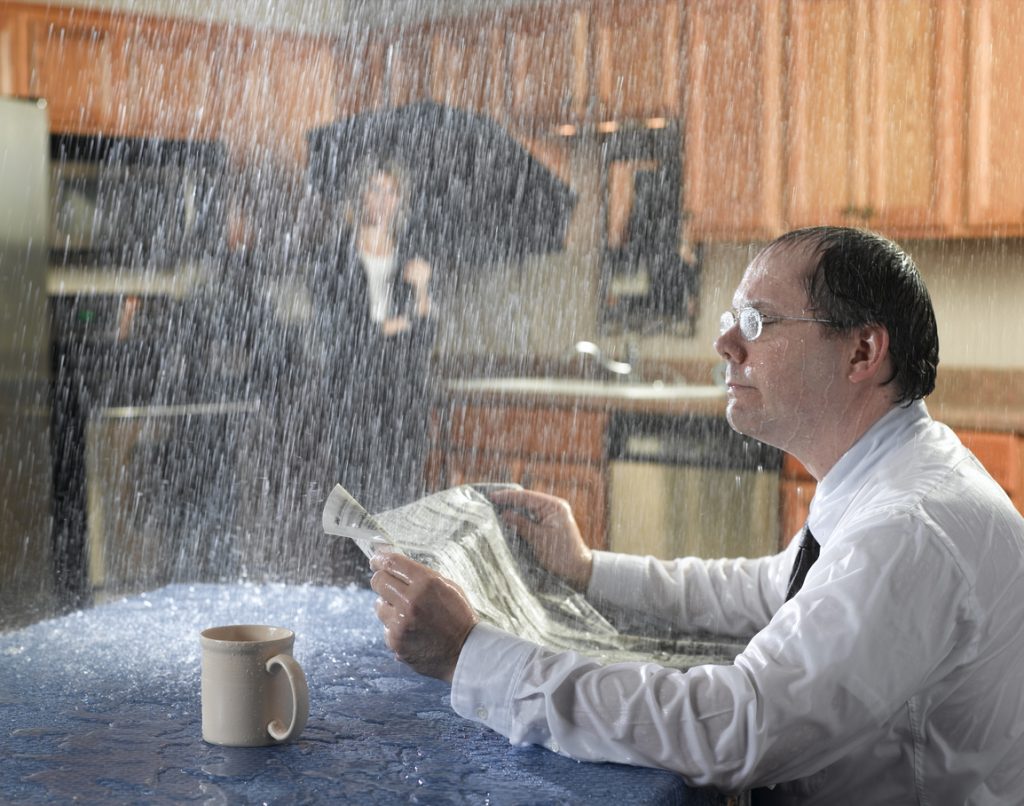(*Note: This guest blog is by Steven M. Thomas, President of Roof Leak Detection Company, Inc., a Certified Testing Laboratory located in South Florida which specializes in testing and consulting services for commercial and industrial properties).
On numerous occasions I’ve had the unfortunate burden of informing building owners that their roofing system is no longer repairable and must be replaced. This revelation, that the roof must be replaced, becomes a big surprise when the tenants of the building report that the roof is not even leaking. “How can that be?” is usually the first question that is asked. Why must it be replaced!?
Depending upon the roof composition and supporting deck type, there can be multiple reasons why a bad roof does not leak. While there are numerous potential reasons, the most common are:
- Concrete decks tend to not let water migrate into the interior of the building.
- Sub-surface insulation boards can absorb large quantities of water and never leak into the interior.
- Light weight concrete is very absorbent and can greatly reduce noticeable leakage into the interior. This is one the reasons why light weight concrete is so widely used on big retail centers.
For Example: The following is based on a recent insurance claim I worked on. A thirteen building complex in Boca Raton, Florida, did not know that their roofs were damaged. No one reported any leaks after Hurricane Frances had impacted the property in September of 2004. However, a wise property manager and Board President sent their maintenance personnel to do a cursory inspection of the roof to see if any damage was visible. The property had carport awnings and trees blown down, however the maintenance personnel reported that other than the drains being clogged on every roof, none of the roofs appeared to have been uplifted. The maintenance personnel did report that over a foot of water was present on each roof but one. The roof that had no ponding water was the only building in the complex that had a walk-out stairwell to the roof; this stairwell acted as an overflow for the roof and is the only reason why ponding water was not found on that particular roof.
The Association filed an insurance claim for the damage. They asked the insurance adjuster to look at the roofs, because every community around the complex was getting new roofs. The insurance adjuster did report that he observed several scrapes and gouges to the roof membrane on each of the buildings, however it was his position that the roof damage he observed was not over the deductible.
The Manager and Board President, not believing the insurance company adjuster, then hired a public adjuster to assist them in the claims process. The Association also hired a roofing consultant to evaluate the condition of the roofs. The roofing consultant hired by the Association performed Nuclear Moisture Surveys on each building and found that 12 of the 13 roofs were saturated with moisture. The insurance company did not believe the results of the Association’s consultant and decided to hire their own company to perform another Moisture Survey on three of the thirteen buildings in an effort to refute the Association consultant’s conclusions.
The company hired by the insurance company performed an Infrared Moisture Survey. The buildings had been re-roofed just two years prior to the storm event. The roofing systems at the complex are smooth surfaced silver reflective coated with six inches of light weight concrete. The Infrared Survey is not recommended for usage on this type of roofing assembly by ASTM or anybody with knowledge about infrared testing for roofs. The results were inconclusive according to the insurance carrier’s Infrared Moisture testing company. However, the company adjuster, believing he had fulfilled his duties to report that he found no damages over the deductible, denied the claim.
The Association was then forced to hire an attorney. The attorney subsequently hired my firm. After reviewing all of the previous tests performed on the roof, Roof Leak Detection personnel performed our own testing. The testing included a Roof Moisture Survey (Nuclear Method), Gravimetric Core Analysis on each roof, Wind Uplift and Fastener Uplift testing.
Our objective was to find out the condition of the roof before we opined on how the roof came to be in the condition we found it at the time of our evaluation. Insurance companies would be better served by their experts if the experts would take the same approach prior to making an opinion about the condition of a roof. I have performed hundreds of roof evaluations for insurance companies and not once did I ever give an opinion as to the condition without performing some type of roof testing. In my opinion a roof condition report without performing accepted scientific testing is unprofessional and cheats both the insured and insurance company. Would you let a Doctor tell you, you need to replace your knee without performing an X-Ray or MRI? Of course not! Then why would you believe an analysis of your roof without any testing being performed?
Our Roof Moisture Survey determined that the roofs on 12 of the 13 buildings were indeed saturated, as the Association’s consultant had found three years earlier (wet insulation does not dry out). We performed wind uplift testing to measure the performance of the roof in its present condition and found that the saturation of the light weight concrete severely diminished the roofing systems uplift capabilities. We conducted fastener uplift test into the light weight concrete to measure the uplift resistance of a like kind fastener and found that the light weight concrete could no longer provide the minimum resistance values for the like kind fastener. We performed Gravimetric Core Analysis on each roof to determine exact moisture contents. Through all of the testing performed, we were able to determine the condition of the roof and whether the underlying insulation would be useful in any future re-roofing applications. We proved without a doubt that the light weight concrete was damaged beyond repair and must be completely removed prior to a new roofing system being installed. We were also able to pinpoint the causation for how the moisture entered the roof during Hurricane Frances. It was not that difficult to figure out! Had the insurance carrier expert been there to truly evaluate the roofs’ conditions rather than taking on the roll of damage deniers, the good people of this community would not have waited so long for this case to settle.
The insurance adjuster and their experts hung their hat on the belief that if a roof is not leaking then it can’t be damaged. The insurance company adjuster and experts overlooked obvious signs of moisture infiltration into the roofing system and did not believe the first set of Roof Moisture Surveys that were performed by a certified testing company. In fact, the insurance company experts attempted to refute the first set of Moisture Surveys by cutting one core on one building to determine that all of the first Moisture Surveys were incorrect. The sad part is that the carrier believed them.
Even when my firm provided another Certified Moisture Survey they were skeptical. The first testing company and my firm are certified testing companies; however the carrier’s expert insisted on having another company perform another Nuclear Moisture Survey, the company they hired was not a certified testing company; however they came up with the same results as we did. The insurance company eventually paid a claim of over $5,000,000.00. The carrier reportedly paid over $250,000.00 in expert fees. What a waste! Had their experts been diligent, and followed accepted procedures for evaluating roofs, the case would have been settled much sooner.
If your property has been in the path of a hurricane, tornado or severe straight-line wind event, have your roof inspected by qualified independent personnel. Insist on scientific testing to back up any opinions from either the insurance carrier or your own engineering or roof consulting firm, DO NOT ACCEPT VISUAL OBSVERVATION REPORTS. Failure to accurately evaluate damage could lead to further damage to the property. More importantly though: never assume that because a roof does not leak, it was not damaged.
Steven M. Thomas
President
Roof Leak Detection Company, Inc.


